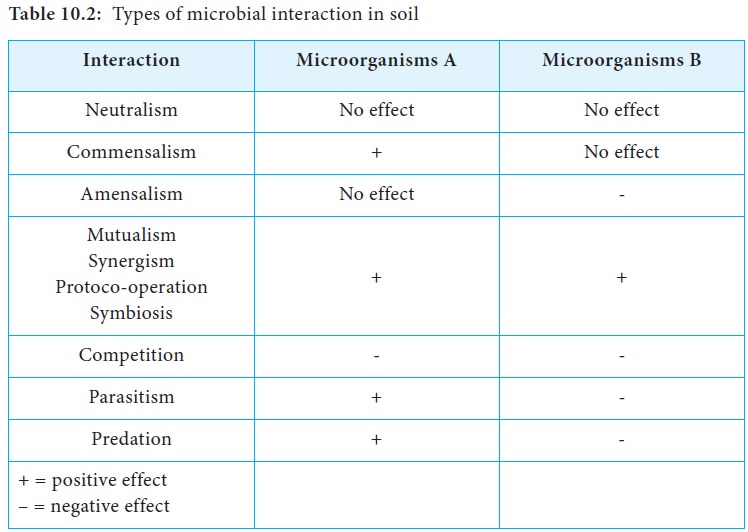Soil Microbiology - Microbial Interactions | 11th Microbiology : Chapter 10 : Soil Microbiology
Chapter: 11th Microbiology : Chapter 10 : Soil Microbiology
Microbial Interactions
Microbial Interactions
Microorganisms in soil interact with themselves and lead to
beneficial and harmful relationships (Flowchart 10.1). Some of the interaction
and interrelationship have been discussed in this connection in Table 10.2.


Beneficial Interactions
The beneficial interactions such as symbiosis (mutualism) and commensalism are found to operate among the soil inhabitants.
Symbiosis (mutualism)
Mutualism is an example of symbiotic relationship in which each
organisms benefits from the association. One type of mutualistic association is
involving the exchange of nutrients, between two species, a phenomenon called
syntrophism. Many microorganisms synthesise vitamins and amino acids in excess
of their nutritional requirements. Other have a requirement for one or more of
these nutrients. Symbiosis is an obligatory relationship between two
populations that benefit both the population. Both populations live together
for mutual benefit.

The relationship between algae and fungi that result in the
formation of lichen is a classical example of mutualistic intermicrobial
relationship (Figure 10.3).
Lichens are composed of primary producer, the phycosymbiont
(algae) and a consumer the mycosymbiont (fungus)

Commensalism
In a commercial relationship between two microbial population,
one population is benefited and other population remains unaffected.
Commensalism is an unidirectional relationship between two population. The
unaffected population does not benefit by the action of second population. For
the receiving population, the benefit provided may be essential. In
commensalism, the unaffected population modifies the habitat in such a way that
another population is benefited.

For example: A population of facultative anaerobes utilizes
oxygen and creates a habitat suitable for the growth of anaerobes. In soil, vitamin
and growth factor producing organisms benefit vitamin and growth factors
requiring organisms.
Harmful Microbial Interactions
Harmful microbial interaction is otherwise described as negative
interaction or antagonistic interaction. Any inhibitory effect of an organism
created by any means to the other organism is known as harmful interaction or
antagonistic interaction and the phenomenon of this activity is called
antagonism
Ammensalism
Ammensalism is the phenonmenon where one microbial species is affected
by other species, where as other species is unaffected by first one.
Ammensalism is accomplished by secretions of inhibitory substances such as
antibiotics. Certain organisms may be of great practical importance, since they
often produce antibiotics or other inhibitory substances, which affect the
normal growth of other organisms. Antagonistic relationships are quite common
in nature. For example: Pseudomonas
aeruginosa is antagonistic towards
Aspergillus terreus (Figure 10.4).

Parasitism
This is a relationship in which one of the population benefits
from the other and the host is usually harmed. Parasitism is one of the most
complex microbial interactions. The line between parasitism and predation is
difficult to define. The parasites feed on the cells, tissues or fluids of
another organisms the host, which is harmed in this process.

The parasites depends on the host and lives in intimate physical
and metabolic contact with the host. All types of plants and animals are
susceptible to attack by microbial parasites.
The rhizospere region can be divided into two zones.
·
Exorhizosphere
·
Endorhizophere
However the root surface is termed as “rhizoplane”.
Related Topics